
table of contents
- Occidental tree of life (Thuja occidentalis)
- Boxwood (Buxus sempervirens)
- Yew tree (Taxus baccata)
- Firethorn (Pyracantha coccinea)
- Large-leaved barberry (Berberis julianae)
- Hedge myrtle (Lonicera nitida)
- Cherry laurel (Prunus laurocerasus)
- Leyland cypress (Cupressocyparis leylandii)
- Spoon Ilex (Ilex crenata)
- Portuguese laurel cherry (Prunus lusitanica)
- False cypress (Chamaecyparis lawsoniana)
- Umbrella bamboo (Fargesia murielae)
- Holly (Ilex x meserveae)
- frequently asked Questions
Evergreen Hedge plants offer year-round privacy. However, the selection of plants that are green all year round is manageable. Numerous cultivars with optical varieties allow hedges to be designed in different ways.
In a nutshell
- Domestic hedge plants are characterized by their high tolerance to frost
- Tree of life and cypress quickly form an opaque hedge
- Firethorn and holly berries are attractive fruit decorations in autumn
Occidental tree of life (Thuja occidentalis)
The occidental tree of life is the most common hedge plant. It also copes well with problematic soils and is extremely easy on pruning. In winter, some varieties have an attractive color with copper-red shoot tips.
- Height: up to 1000 cm
- Growth habit: upright, slender
- Annual growth: 20 - 40 cm
- Required space: 200 - 300 cm
- Leaves: green needles
- Soil: moderately moist, normal garden soil

There are different cultivars of the occidental tree of life, which differ, for example, in terms of color or speed of growth.
Popular varieties for an opaque hedge are:
- May green
- emerald
- Brabant
- Columna
- Golden emerald
- Sunkist
- Aurescens
Note: Regular pruning is essential for the occidental tree of life. The plants no longer sprout from the old wood, which is why unkempt or overaged plants usually have to be replaced.
Boxwood (Buxus sempervirens)
Of the Boxwood was a popular hedge plant, especially in baroque gardens. Here, low hedges were deliberately created as landscape elements, as the box tree grows only slowly.
- Height: up to 450 cm
- Growth habit: upright, bushy
- Annual growth: 5 - 20 cm
- Required space: 100-200 cm
- Leaves: ovate, dark green, leathery
- Soil: normal garden soil
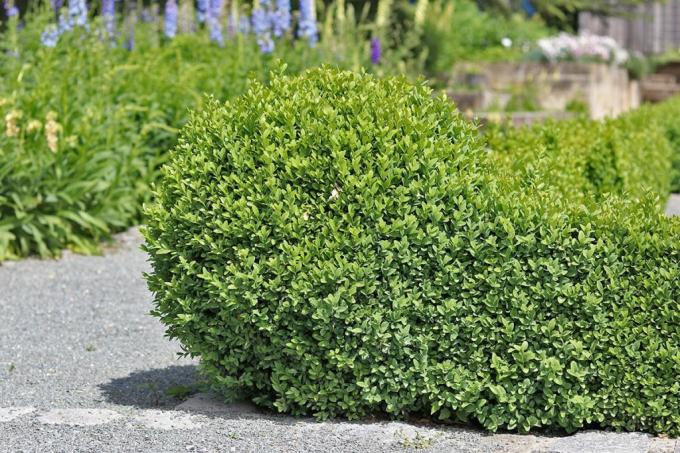
The box tree is an ideal hedge plant for locations in full sun. Compared to many other plants, it can withstand extreme temperatures thanks to its firm leaf structure. In recent years the boxwood has been increasingly affected by an introduced butterfly, the boxwood moth. However, there are now some preparations on the market that can be used to keep the insect in check if it is controlled early.
Yew tree (Taxus baccata)
The yew tree is one of the hedge plants that has been gaining popularity for several years, although the plant is poisonous. The reason for its popularity is that it forms an opaque hedge within a short time and is also very easy to cut. As a result, it has always been a popular topiary, because even strong pruning does not harm it and it recovers quickly.

- Height: up to 1000 cm
- Growth form: upright, bushy, heavily branched
- Annual growth: 20 - 30 cm
- Required space: 30 - 40 cm
- Leaves: needle-shaped, glossy, dark green
- Soil: undemanding, clayey - loamy soil, permeable
Firethorn (Pyracantha coccinea)
The firethorn is an underestimated hedge wood that was previously mainly used as a solitary plant. With the right pruning, the plants form an evergreen and opaque hedge that does not take up much width. In autumn, the fruit decorations are popular with birds.

- Height: up to 300 cm
- Growth habit: upright
- Annual growth: 20 - 50 cm
- Required space: 20 - 30 cm
- Leaves: oval, leathery, dark green
- Soil: normal garden soil, well drained
Tip: The firethorn is available with different fruit decorations. The “Red Column” variety has red berries and “Orange Glow” orange fruits.
Large-leaved barberry (Berberis julianae)
the Barberry is extremely adaptable when it comes to climate extremes. It withstands dry summers as well as extreme cold in winter without any problems.

- Height: up to 300 cm
- Growth form: upright, dense, overhanging
- Annual growth: 30 - 40 cm
- Required space: 30 - 40 cm
- Leaves: oval, shiny
- Soil: undemanding, moderately rich in nutrients
Hedge myrtle (Lonicera nitida)
The hedge myrtle is an evergreen small perennial that is not suitable for the edging of properties. It should be protected from the wind and, due to its height, is an ideal hedge within the garden to give structure to an area.
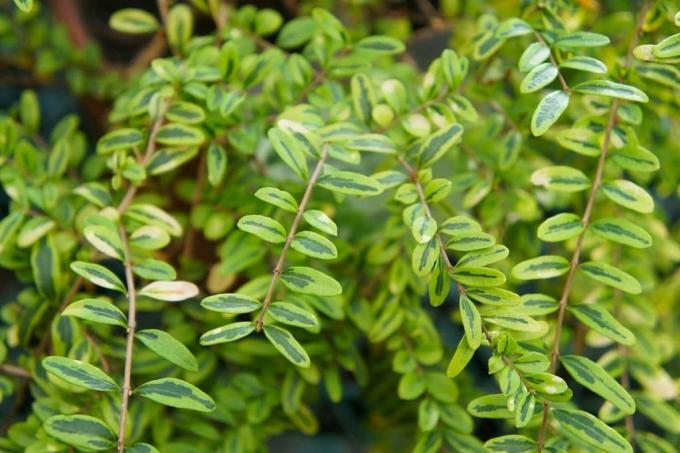
- Height: up to 100 cm
- Growth habit: low, compact
- Annual growth: 15 - 25 cm
- Required space: 20 - 30 cm
- Leaves: medium green, shiny, small, oval
- Soil: undemanding
Cherry laurel (Prunus laurocerasus)
Of the Cherry laurel is still a comparatively young hedge wood, which, however, quickly found great approval due to its properties. The reason for this is that they have excellent frost hardiness. Especially after a few years, when they are deeply rooted in the ground, they can hardly be affected by extreme weather conditions. The cherry laurel is also suitable for a hedge of great height. Even with its full length of 3.5 meters, it is still robust and strong.
- Height: up to 350 cm
- Growth form: upright, strong
- Annual growth: 15 - 40 cm
- Required space: 30 - 50 cm
- Leaves: dark green, elongated, oval, shiny
- Soil: normal garden soil
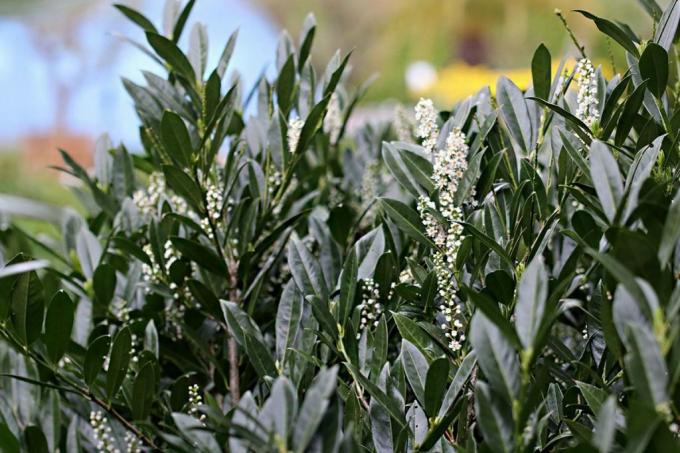
There are also different cultivars of cherry laurel that have slight optical varieties.
Selection of varieties:
- Caucasica
- Etna
- Herbergii
- Novita
- Rotundifolia
- Genolia
Leyland cypress (Cupressocyparis leylandii)
Cypress and Thuja are often confused. However, these are different species that also have different demands on maintenance or the soil
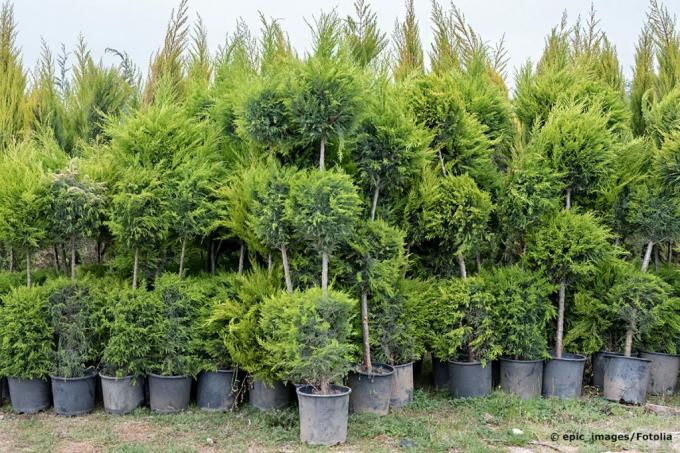
- Height: up to 2500 cm
- Growth form: upright, conical
- Annual growth: 40 - 100 cm
- Required space: 30 - 60 cm
- Leaves: small, green, needle-shaped
- Soil: fresh, moist, soil-tolerant
The Leyland cypress is a popular plant when an evergreen and opaque hedge is needed quickly. In good conditions, it can easily grow by up to one meter per year.
Spoon Ilex (Ilex crenata)
The Spoon Ilex has no stinging leaves and is therefore preferred as a hedge plant compared to Ilex meserveae. Due to its intolerance to wind, it is not suitable as a border planting. However, it can be used as a structure-giving hedge plant in gardens.
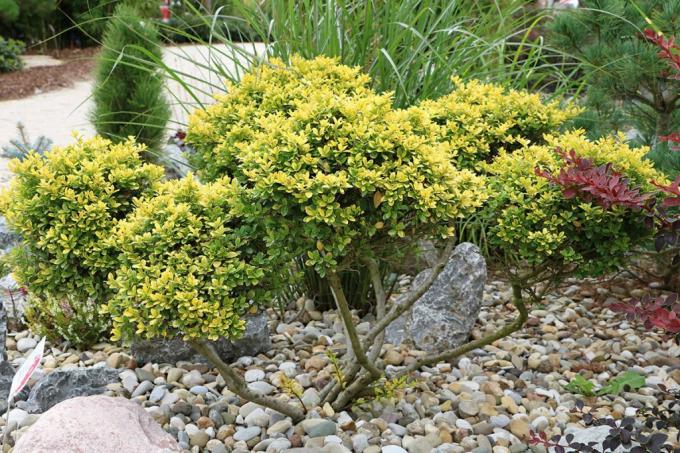
- Height: up to 150 cm
- Growth habit: low, dense, compact, spreading without regular pruning
- Annual growth: 5 - 15 cm
- Required space: 20 - 30 cm
- Leaves: small, dark green
- Soil: normal garden soil
Portuguese laurel cherry (Prunus lusitanica)
The Portuguese cherry laurel is related to the cherry laurel. Compared to Prunus laurocerasus, this species is much better suited for locations in full sun.

- Height: up to 400 cm
- Growth habit: upright, heavily branched
- Annual growth: 10 - 30 cm
- Required space: 30 - 50 cm
- Leaves: dark green, shiny, ovate, pointed
- Soil: normal garden soil
False cypress (Chamaecyparis lawsoniana)
Breeds of false cypresses are characterized by different colors. There are varieties with blue tones or multicolored cultivars that have white tips.

- Height: up to 500 cm
- Growth habit: columnar
- Annual growth: 10 - 20 cm
- Required space: 50 - 70 cm
- Leaves: green, needle-shaped
- Soil: normal garden soil
Umbrella bamboo (Fargesia murielae)
bamboo in the garden is not welcomed by many gardeners, because many have bad experiences with Collected varieties that form strong runners and therefore large areas within a short time overgrow. However, this does not apply to Fargesia species. They form little or no runners, the rhizome increases in size over the years with new shoots. The umbrella bamboo is an attractive addition to the common hedge plants, but it takes some time to create an opaque hedge.

- Height: up to 300 cm
- Growth habit: umbrella-shaped
- Annual growth: 20 - 40 cm
- Required space: 50 - 60 cm
- Leaves: light green, elongated
- Soil: well-drained, nutrient-rich, moderately moist, slightly acidic
Note: In winter, the evergreen umbrella bamboo can suffer from a high snow load. It should therefore be cleared of snow in good time before the individual shoots are pushed apart.
Holly (Ilex x meserveae)
The holly is one of the most unusual hedge plants, but offers advantages because the thorns also keep different animals from entering the garden. The holly is characterized by a very good winter hardiness and this already applies to young plants.
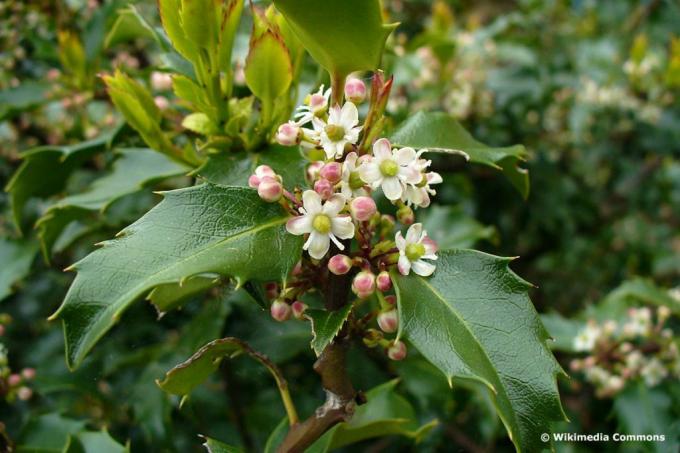
- Height: up to 400 cm
- Growth habit: upright, densely branched
- Annual growth: 20 - 40 cm
- Required space: 30 - 40 cm
- Leaves: dark green, glossy, elliptical, thorns on the leaf margin
- Soil: nutrient-rich, constantly moderately moist
frequently asked Questions
For some plants that grow slowly, such as boxwood, you can also use less space. This means that older plants need to be pruned more frequently.
Most evergreen plants that form an opaque hedge usually have very inconspicuous flowers. Only the cherry laurel and the holly have recognizable flowers. However, some species have attractive fruit decorations, including the holly or the yew. The firethorn has both attractive flowers and attractive fruit decorations.
No, the hedge plants should only be freed from it when there is a heavy snow load so that no branches break off and leave unsightly holes.
The rhododendron is not particularly compatible with pruning and is therefore not suitable as an evergreen hedge plant. Only a hedge that does not have a strict cut can complement the rhododendron.

